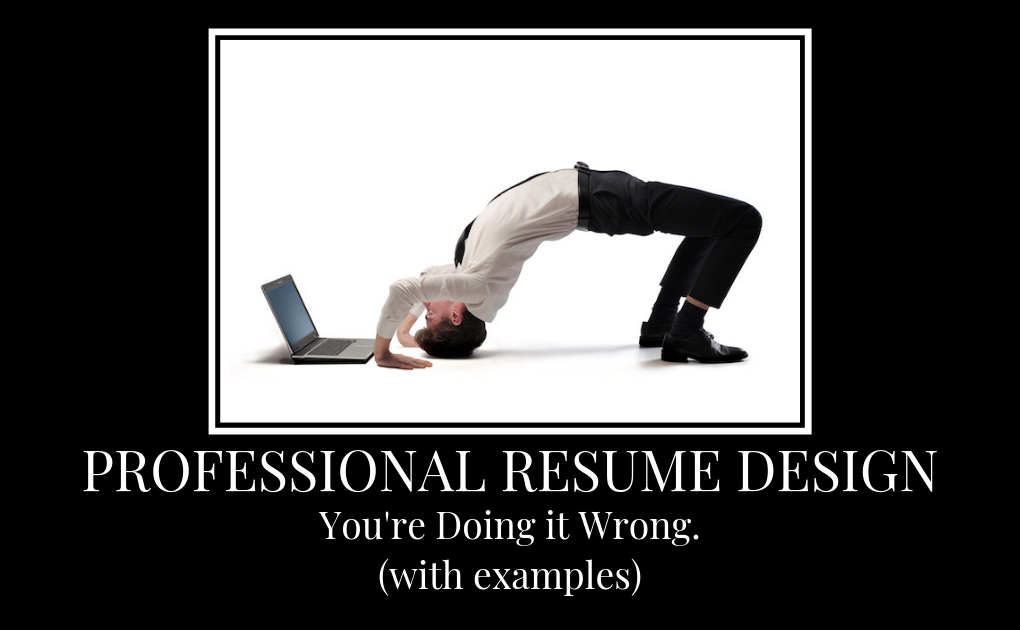As an experienced professional resume writer, I see a lot of resume examples that are shockingly bad- for a variety of reasons. If you need a little resume help or if you’re looking for ideas on how to write a resume, this article is for you.
Here is a list of items you can use to improve your resume immediately:
Ditch the Template
Resume templates are convenient, easy to use, and horribly boring. In today’s job market, you need to be genuine and unique, and be able to grab the attention of a hiring manager right away. A resume template will notdo this.
Of course, there are guidelines you can follow and resume examples you can look to for inspiration, but you’ll also want to tailor your resume to best highlight your skills, experience and accomplishments. Otherwise, you risk blending in with everyone else.
The Infographic Resume
I used to dislike infographic resumes for non-design professionals, but I’m warming to the idea of them in a few instances. Visual resumes can be a great addition to your LinkedIn profile or as a supplement to your resume and cover letter in a direct email to a hiring manager, but you have to be careful.
In Alison Doyle’s article How to Create an Infographic Resume, she states,
“Generally speaking, unless requested, hiring managers prefer traditional resumes over infographic resumes. Unless you are a design professional, it can be really hard to pull off a great infographic resume, and sending in a not-so-great one is likely to do more damage than good.”
Traditional resumes are still the way to go, especially if you are applying online through an Applicant Tracking System (ATS). Infographic resumes will likely be rejected immediately by these sorting systems because of their inability to process the data correctly.
Resume Length
Debate on this subject can be traced back to the invention of the paper resume, I’m sure of it. However, in the digital age, it is acceptable to have a 2-page resume. Although, as with most resume variables, page length depends on an individual’s set of circumstances.
One page is typical of a new graduate, entry-level, or career change resume, whereas a professional with more experience may have the need to fill another page.
If you’re not sure how long your resume should be, contact me and I can help you decide with a free consultation and resume review.
Page Margins
The margins are often overlooked when it comes to resume formatting, but they can be helpful with adjusting clarity and flow. Smaller margins allow you to fit more content onto one page, and larger margins can help less content fill more of the page.
Utilize the space to fit your needs but take caution not to overwhelm the page with text.
The Resume Objective
Please, don’t use a resume objective. Today’s employers are looking for what you have to offer and how you can contribute, so instead of an objective, begin your resume with a Professional Profile.
Your profile can include items like a title (or other keywords identifying your role), a positioning statement, and a skills section.
Examples of a resume title include, Sales and Marketing Manager,Business Operations Executive, Senior Financial Management & Account Executive, andSenior-Level Retail Manager.
The positioning statement is typically 3-5 sentences summarizing your experience, accomplishments, skills, and plans for immediate contribution. Use keywords, especially from the job posting (if there is one) and try to word your statement with the goal of helping the hiring manager to visualize you in the role.
Work Experience
Reverse-chronological is best. Start with your most recent position and work your way backward. Keep the details relevant and shy away from any experience that is over 15 years old.
Pro Tip: For clarity, list your dates of employment uniformly on the right side of the page.
In the job description, try to focus more on what you accomplished rather than listing your job duties. And, for any achievements, keep them relevant by listing them under the job in which they were achieved.
Education
If you are a new graduate, you may want to list your education before your work experience. Otherwise, you’ll most likely want to list your education after your experience.
I recommend listing the institution, degree(s) earned (or courses completed), field(s) of study, and any special honors, recognitions or other relevant details to the position you are applying to. Dates are optional, and including them opens you up to age discrimination, so I typically advise against their use here.
Other Relevant Details
You can also include more details about yourself, like professional affiliations, licenses and certifications, volunteer experience, publications and presentations, and other relevant details.
Stay away from including detailed personal information like marital status, religious or political affiliations, or other demographics that could open you up to discrimination. Most companies will ignore a resume with too much information for fear that they could be held liable for discrimination.
Want more career-related goodness?
- Get a powerful 5-Step Resume Action Plan that will help you transform your resume into an interview-getting machine.
- Download my 54 Super Impressive Resume Action Verbs list by joining the Career Courage Facebook group.
- Find more DIY career resources here.
- Apply now for a free strategy call if you’re thinking about 1:1 services with a career expert.
